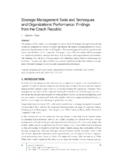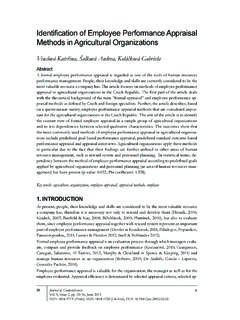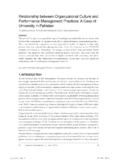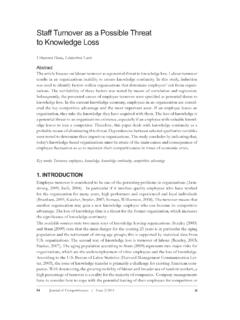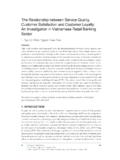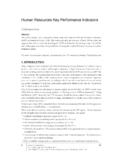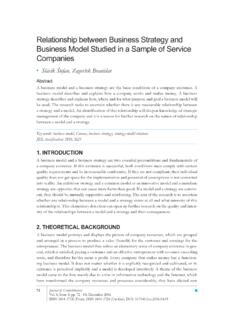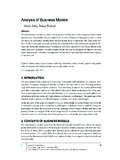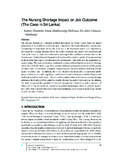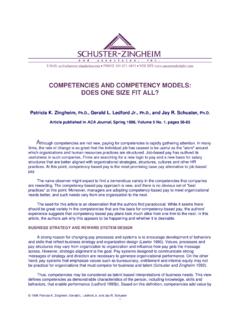Transcription of Competitive Advantage Achievement through …
1 Journal of Competitiveness Competitive Advantage Achievement through innovation and KnowledgeUrbancov HanaAbstractIn today s highly Competitive environment the goal of each organisation is to defeat competition and win new customers. Individuals who are holders of knowledge represent a tool for the gen-eration of innovations. Thanks to their personal creativity, their knowledge, skills and abilities it is possible to generate new innovative ideas that will help organisations to achieve a Competitive Advantage .
2 The aim of the article is to present the findings of a survey targeted at innovations and to identify knowledge as an important element in the process of innovations. Primary data were obtained through a questionnaire survey carried out in organisations in the Czech Repub-lic and evaluated using the tools of descriptive statistics and also the methods of comparison, induction, deduction and synthesis were applied. One of the conclusions of the article is that organisations find it important to innovate and support an innovative culture.
3 Knowledge too is very significant in the innovation process since it represents not only important input, but also output of the transformation words: knowledge, innovation , Competitive Advantage , organisations, questionnaire survey1. INTRODUCTIONA uthors (Bartes, 2009; Hamel & Green, 2007; Senge, 2007; Bart k, 2006; Collinson, 2005) agree that the 21st century is based on knowledge, information and innovative economy. Organisa-tions success depends on employees knowledge, experience, creative activity and qualification and emphasis is placed on continuous learning and research and in 1986 Tushman & Nadler stressed that organisations can gain Competitive Advantage only by managing effectively for today while simultaneously creating innovation for tomorrow and suggested that there is perhaps no more pressing managerial problem that the sustained management of innovation .
4 Tushman & Nadler (1986) identify visionary leadership and also people, structures and values as important factors that affect whether an organisation realizes benefits from innovation . innovation is still seen as a critical drive of economic this respect, education has been pointed out as a key aspect for the economic success of the every organisations (Romero & Martinez-Roman, 2012; Kangasharju & Pekkala, 2002). Since knowledge is a fundamental factor in the innovaton and assimilation of new technologies (Romero & Martinez-Roman, 2012; Hoffman et al.)
5 , 1998), individual training plays an important role contributing to the internal learning and the generation of new ideas within the business (Galende & De la Fuente, 2003). The education background of the managers, business owners and entrepreneurs has been found to be an important factor explaining innovation in organi-sations (Koellinger, 2008). The research shows (Romero & Martinez-Roman, 2012; Romero, 2009) that the organisational taking part in value chains could stimulate their processes of inno-Vol.
6 5, Issue 1, pp. 82-96, March 2013 ISSN 1804-171X (Print), ISSN 1804-1728 (On-line), DOI: 18:24:59 vation and technological improvement by the spill over of knowledge and demands from larger organisations, while others consider that this possibility has been overestimated. On the other hand, business cooperation can be an important route for the transmission of the knowledge and experience in the production network. This is even more important in the case of small organisa-tions because, in comparison to large organisations, they have a reduced innovative autonomy and they do not usually collaborate with technological centers (Romero & Martinez-Roman, 2012; Dyer & Singh, 1998).
7 Based on the above it can summarize that innovative projects and Competitive Advantage of these organisations are dependent on the goal of sharing resources and paper presents the results of the research focused on innovation and discusses the impor-tance of knowledge in the area of innovation . The paper was based on the evaluation of quan-titative research. The first part contains the theoretical background which presents the author s views on this area and the results of the foreign research. The next chapter contains the objective of the paper and describes the methodology of the survey according to which was processed, analyzed and evaluated obtained primary data.
8 The chapter Results is divided into the four parts which focus on summarizing the results of survey in the Czech Republic, the evaluation of re-sults, the verification of results and on the importance of knowledge in the innovation process. The chapter discussion and conclusion includes the summary and specifies the preconditions to gain innovativeness in the THEORETICAL BACKGROUND OF THE WORKThe term innovation as such was used for the first time by Schumpeter at the beginning of the 20th century.
9 His ideas and research have been developed by a number of other authors. Schumpeter defined innovations as product, process and organisational changes that do not necessarily originate from new scientific discoveries ( i lavsk , 2011), but may arise from a com-bination of already existing technologies and their application in a new kontext ( i lavsk , 2011). innovation also originates from public research (Autant-Bernard, 2001). It is therefore possible to summarise that according to these definitions innovations do not cover only technical and technological changes and improvements, but in particular practical application and particularly originates from capital and creative research work are according to Zemplinerov (2010) and Autant-Bernard (2001) considered the most important determinants of innovation .
10 Adair (2004) states that any innovative organisation should have a bucketful of ideas. According to Ko turiak & Cha (2008), Skarzynski & Gibson (2008), Tidd, Bessant & Pavitt (2007) an innovative process can be divided into two essential parts. One part is inventive associated with the generation of the original idea, thought or concept and the second innovative, during which the inven-tion is implemented and marketed. Pitra (2006) states that innovation is the result of employees creativity in an organisation and must be always targeted at customers and bring added value.
